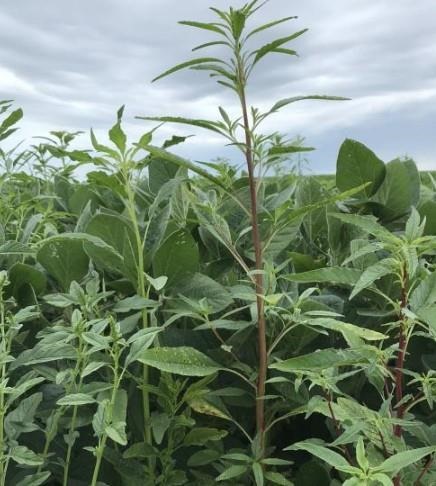By Prashant Jha
This is the time of the year when late-season pigweeds (waterhemp and Palmer amaranth) poke through the soybean canopy and produce seeds. These late-season pigweeds either emerged after herbicide applications, or survived inappropriately timed or less-than-effective postemergence herbicides. Given waterhemp and Palmer amaranth’s propensity to evolve resistance to herbicides, it is also possible that the survivors are resistant to the postemergence herbicide that was used. Based on our recent statewide survey conducted in 2019-2020, waterhemp populations with multiple resistance to five different herbicide groups (HGs 2, 5, 9, 14, and 27) are evident in Iowa production fields and cases of resistance continue to escalate in the state. The development of resistance to dicamba, 2,4-D, or glufosinate may occur in the near future given their intensity of use in corn and soybean fields.
Effective management of waterhemp and Palmer amaranth has been one of the primary goals of our weed educational programs. For Palmer amaranth specifically, a focus on preventing spread and eliminating populations is key. There is information on late-season identification of Palmer amaranth vs. waterhemp. One of the most important points about these two pigweeds is their ability to produce more than 500,000 seeds/plant. Furthermore, those seeds can remain viable in the soil for 4-5 years.

Figure. Late-season waterhemp infestation in soybean.
It is essential to scout fields this time of the year and kill or remove plants that can produce seed. Allowing even a few plants to produce seed would increase the population for subsequent years. Running a combine through plants loaded with seed is a primary mechanism of spread of resistance within and across fields. Although these late-season survivors in a field are unlikely to impact soybean yields, the best way to make sure that resistance does not develop is to follow herbicide programs with later-season scouting and removal of plants to prevent seed production.
The most effective way to prevent seed production is to pull plants or cut off them at the soil surface and remove those from the field because pigweed plants can re-root at the nodes and regrow. The effectiveness of late-season herbicides is highly variable and questionable at this point. Good coverage is an issue this time of year due to height differential between the weeds and soybean. HG 14 (PPO inhibitors) herbicides are the only options in soybean, with the following preharvest restrictions: Lactofen (Cobra) – 45 days before harvest (DBH); fomesafen (Flexstar/Reflex) – 45 DBH; acifluorfen (Ultra Blazer) – 45 DBH. Carryover and injury to corn from late-season applications of fomesafen (10-month rotational restriction) is quite possible. These herbicides would be ineffective for waterhemp populations that are resistant to PPO inhibitors. None of these herbicides are likely to kill large pigweeds although they may suppress smaller plants and reduce seed production. While other species may be killed with late-season herbicides, the impact on seed production will be highly variable. This will mostly depend on the stage of weed seed development. Late-season herbicide applications are more effective in reducing viable seed production at the early flowering stages of the weed.
Scout fields from now into September to remove any waterhemp and Palmer amaranth plants in the field with the goal to prevent seed. Scouting should include local roadsides and waterways, field borders, and fence lines. We also need to consider alternative control tactics that can fit into the current weed management system. Now is the time to think about integrated weed management tactics including harvest weed seed control methods (chaff lining and weed seed destructors).
Source : iastate.edu